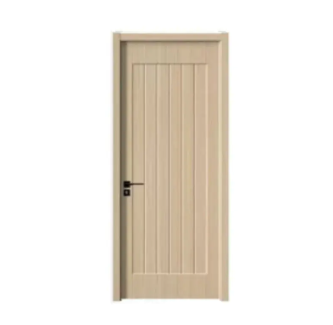WPC doors have gained attention in recent years as a practical alternative to traditional wooden and metal doors. The term "WPC" stands for Wood Plastic Composite, which means these doors are made from a combination of wood fibers and plastic materials. This blend results in doors that bring together the aesthetic appeal of wood and the durability of plastic. Many industries and homeowners are considering WPC doors due to their unique characteristics and performance.
One of the significant advantages of WPC doors is their resistance to moisture. Unlike pure wooden doors, which can warp or swell when exposed to water, WPC doors tend to maintain their shape and integrity even in humid environments. This feature makes WPC doors suitable for use in bathrooms, kitchens, or external entrances where exposure to moisture is common. For areas that experience heavy rainfall or high humidity, WPC doors offer a dependable solution.
Another important property of WPC doors is their resistance to pests. Traditional wooden doors often suffer from termite attacks or other insect damages. WPC doors reduce this risk because the plastic component discourages pest infestation. This quality extends the lifespan of the door and reduces maintenance costs, which is an attractive factor for both residential and commercial buyers.
The manufacturing process of WPC doors also contributes to their growing popularity. WPC doors are usually produced through extrusion or molding methods, which allow for precise shaping and consistent quality. This production technique helps manufacturers meet various design requirements, whether it is a simple panel door or a more elaborate decorative style. Customers benefit from this flexibility because WPC doors can suit different architectural styles.
Additionally, WPC doors require minimal maintenance. Unlike wooden doors that need frequent painting or varnishing, WPC doors can be cleaned easily with just water and mild detergent. Their surface resists stains and scratches, helping the doors retain their appearance over time. For busy households or commercial spaces, this ease of care is a valuable trait.
From an environmental perspective, WPC doors offer an interesting option. Since they use recycled plastic materials combined with wood fibers, these doors help reduce waste and promote sustainability. Manufacturers are increasingly focusing on eco-friendly practices, and WPC doors fit into this approach by reusing materials that might otherwise end up in landfills.
WPC doors also provide satisfactory insulation properties. Their composite makeup offers some degree of thermal and sound insulation, which contributes to energy efficiency and indoor comfort. This can be beneficial in both hot and cold climates, helping reduce heating and cooling costs in buildings.
When considering installation, WPC doors generally fit into standard door frames with little modification. They come in various sizes and finishes, allowing them to be easily integrated into existing structures. Installation professionals often find WPC doors convenient to work with due to their manageable weight and consistent dimensions.
While the upfront cost of WPC doors can be slightly higher than some traditional doors, the long-term benefits like reduced maintenance, durability, and resistance to environmental factors make them a practical investment. Buyers who value longevity and ease of care often find WPC doors to be a reasonable choice.
WPC doors combine several advantages that make them suitable for a wide range of applications. Their resistance to moisture and pests, low maintenance, environmental benefits, and design versatility contribute to their increasing presence in the market. For anyone considering new doors or replacements, understanding the qualities of WPC doors helps in making an informed decision.
https://www.homely-doors.com/product/interior-door/interior-wpc-door/
